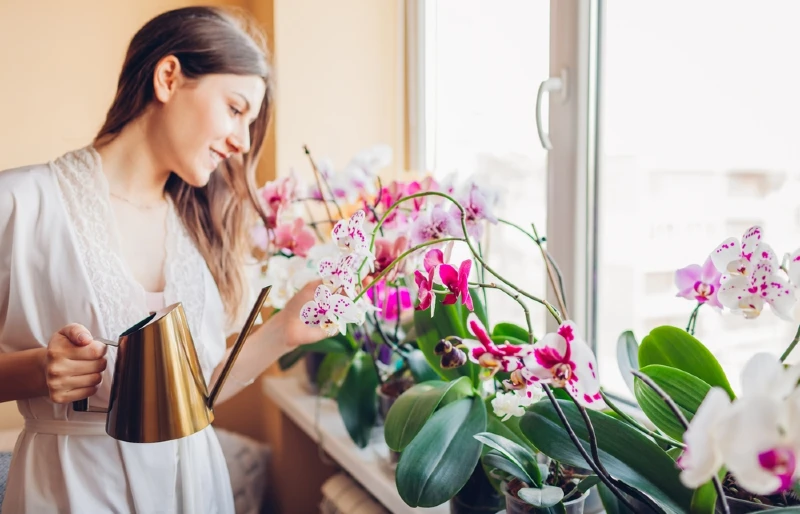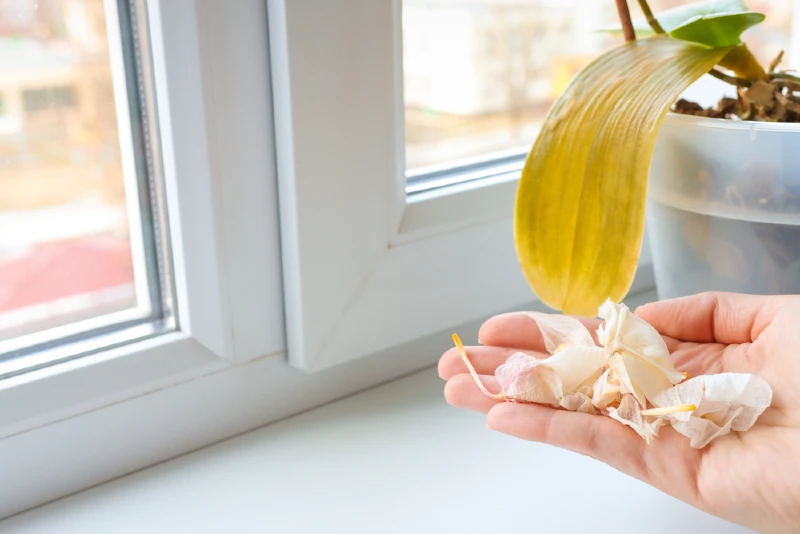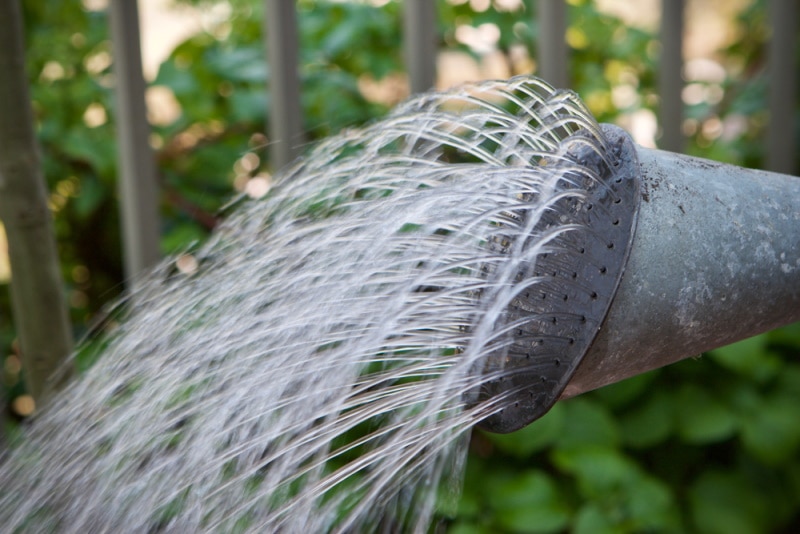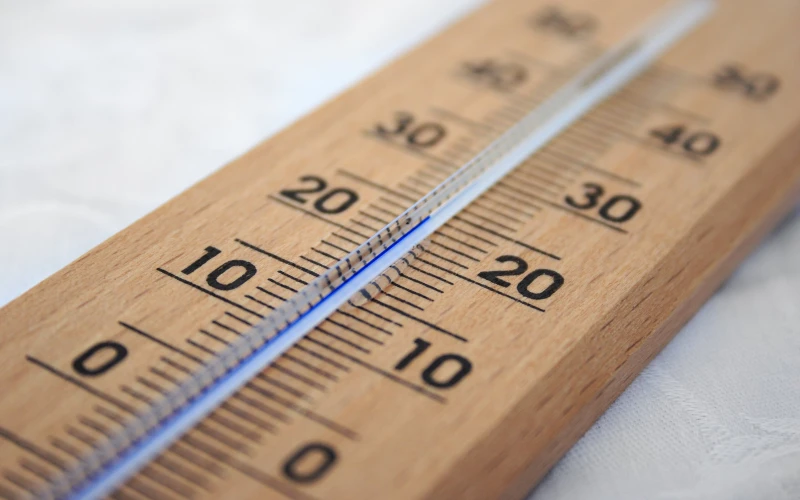Is My Orchid Dead (6 Signs to Look For)
-
Pete Ortiz
- Last updated:

Orchids are among the most beautiful indoor plants you may place in your home to create a colorful and unique environment. Although they could be challenging to grow indoors at times, you could always look for specific species that will do well, given proper growing conditions.
The plant’s tendency to be fussy about where they live may confuse their owners on whether they are still alive, dead, or dormant. During dormancy, the orchid’s blooms fall off, and the only remaining parts are bare stalks.
On most occasions, it is just a phase that an orchid needs to go through to replenish nutrients lost during blooming, but you might think that the plant is probably dead. So how will you identify a dead orchid? Read on to learn more.
The 6 Signs to Tell if an Orchid Is Alive or Dead
If you are unsure whether your orchid plant is dead or alive, check out for the following signs and symptoms.
1. Brown, Mushy Leaves and Roots

Suppose your orchid plant begins developing brown and mushy leaves and roots; then it is dying or already dead. The mushiness is often a result of too much watering. Do not assume that over-watering an orchid will give it a greener and more appealing color; instead, the water becomes too much, and the orchid begins to rot.
An orchid that is in good condition should have roots that are either white or green. When touched, the texture should be firm and not mushy. Also, make a habit of watering your orchid only when necessary.1
Cut off the roots if they are partially rotten; you might just be able to save them from dying.
2. Yellow Leaves

Another sign that an orchid is dead is when the leaves are yellow. However, yellow leaves may not always imply that the orchid is dead. When the leaves at the bottom of the orchid turn yellow, the plant is still healthy, and is just a passing phase that should take place for the plant to produce new greener leaves. But if the entire orchid has yellow leaves, the plant is dying or probably already dead.
3. Falling of Leaves

As observed in the previous point, leaves may be falling off as a phase that the orchid needs to go through so that the plant will produce new green leaves. At the same time, it could be a sign that the orchid is not in good health and may die or is already dead.
Be worried when all the leaves on your orchid plant turn yellow and begin to fall off. Though it is hard to revive an orchid whose entire leaves have turned yellow and fallen off, you can consider looking at the roots and see if they can be saved and salvage the situation.
4. Dark or Bleach Spots

Dark or bleach spots often appear on an orchid plant suffering from fungal disease or pest infestations. At times it is just too much exposure to sunlight. The problem is easily identifiable and can be remedied in good time.
You may remove the plant from direct sunlight or buy a recommended fungal or insecticide. You may also remedy the situation by applying rubbing alcohol to the affected parts of the plant and preventing future recurrence by using products like neem oil.
5. Wrinkled Leaves

Orchids survive better in an environment with high humidity. When you notice the leaves wrinkling, chances are the plant is dehydrated. The fact that too much water may cause the death of your orchid does not mean that you should withhold enough supply for it. You may as well adjust the settings of your humidifier to ensure the plant is never dehydrated to the point of having wrinkled leaves.
6. Skipped Orchid Natural Cycle

Keep a close eye on your orchid; if the plant does not go through the dormancy and blooming phase each year, then something is wrong with its immediate environmental setup. Find the appropriate environmental conditions for an orchid plant and make the required adjustments.
Suppose you notice a skipped blooming phase accompanied by any of the symptoms, such as yellowing of the leaves, the plant may be dying.
Why Your Orchid Is Dying and Possible Remedies
Supposing your orchid is exhibiting any of the above signs and symptoms, one of the following could be the reason. The reasons are also accompanied by remedies that can salvage the situation and save your orchid plant.
1. Overwatering

An orchid may look succulent when fresh, and one may think it survives on too much water. However, excessive watering causes the roots of the orchid to rot, eventually turning the leaves yellow, and your plant dies.
The more water you add to the orchid plant, the more the potting medium stays damp. The roots become overwhelmed, and they result in shrinking and rotting. When the roots rot, they can no longer transport water and minerals from the soil up to the leaves, and that is why they start changing color to yellow.
- Avoid overwatering; only water the plant at least once every 10 days.
- Remove the orchid plant from the potting medium, clean it with an alcoholic disinfectant, allow it to dry, and inspect its roots. If you notice the roots are brown and soft and have an unpleasant smell, they have begun to rot; it is only a matter of time before they become papery white and die back. The roots that can still be saved from dying are still green or gray in color.
- Use sterile scissors that have been disinfected with an alcoholic disinfectant to cut off the rotting parts of the roots so that the rotting does not spread and cause the entire orchid to die back.
- Replant the orchid in the disinfected potting medium or a new one. Ensure the plant is well-soaked to protect it from the replanting shock. Water it after ten days. After replanting the orchid, the yellow leaves might still fall off for new ones to grow.
However, a damaged orchid will only be restored if the plant hasn’t stayed soaked for too long. The number of roots that had rotten and caused the orchid to die back will also determine if the orchid will recover.
2. Underwatering

The same way too much water will cause harm to your orchid is the same way underwatering will. Often, orchid owners focus on the warning that too much water will cause their plant to die and therefore end up forgetting to water it as often as they should. Sometimes the owner waters the plant, but the water is too little to reach the roots of the orchid.
Eventually, the roots of the orchid suffer drought, wrinkle, and die back, making it impossible to transport water and minerals from the soil to the rest of the orchid plant. The orchid leaves will begin to turn yellow and fall off.
- Avoid light watering; generously soak the plant so the water can be absorbed in all the potting medium’s parts, reaching every root. The water will keep the roots fresh and in good health condition to transport water and minerals to the plant.
- Soak your orchid at least once every ten days. Still, you may soak the orchid according to the seasons. For instance, during spring and summer, ensure the orchid is soaked after every seven days. During the fall and winter, ensure to soak the orchid at least once every ten days. The weather is not too hot; therefore, the orchid may not use up water as fast as it would during spring and summer.
- You may or may not chop off the roots that die from underwatering with sterile scissors. However, it is not often advisable since the roots did not die from diseases. Leave the roots alone, especially if they are deep into the potting medium. You may be surprised that some of these dead roots will be revived back to health when you resume regular watering.
3. Too Much or No Sunlight

Placing your orchid directly facing light will cause it to scorch and turn brown or yellow. Therefore, avoid placing your orchid on a window where the sun will have easy access to it. You wouldn’t like it when the sun burns the beautiful leaves and even prevents them from flowering.
The heat from the sun will also cause the flower buds to drop, hence the inability of the orchid to flower.
At the same time, when there are low levels of light, the orchid may also experience some growth difficulties. For instance, it may experience stunted growth and low flower production.
- Orchids require the forest canopy kind of environment with partial sunlight to help your plant flower and protect the leaves from burning and becoming brown. Therefore, place your orchid in an area where there is indirect light so that the site can replicate the forest canopy kind of environment.
- Once the orchid leaves have already turned yellow or brown due to too much sunlight, it is not easy to recover even after you have rectified the situation; they often die and fall off. However, do not try to pull it off the orchid; allow the leaf to fall off on its own. Pulling the leaf may cause flesh damage to the orchid, causing an infection.
4. Sudden Temperature Fluctuations

Orchids survive within a temperature range of 55°F (12°C) during the night and a maximum of 75°F (23°C) during the day. Suppose the temperatures are low; the plant’s leaves begin to turn yellow, droop, die and fall off. At the same time, with high temperatures, the plant begins to lose water from the soil and water through evaporation.
Furthermore, the sudden closing and opening of the door where your orchid is may also cause sudden fluctuations in the temperatures within the room, causing your plant to experience some of the issues mentioned above. You may also notice changes in your orchid where the plant drops flowers or the leaves begin to turn brown and die after you place it close to any heat source in your home.
- Place your orchid in a room with the proper temperature range.
- Also, avoid placing the orchid close to heat sources in the house or any other electronics that may alter the surrounding temperature where the orchid has been set.
5. Use of Moss or Soil-Based Potting Mediums

Moss or soil-based potting mediums are known for retaining too much water or moisture each time you water your orchid. The retained moisture may prevent adequate air circulation within the potting mediums, resulting in your orchid’s death.
This is why most orchids planted in moss or soil-based potting mediums begin to turn yellow, and their leaves fall off and eventually die.
- Get an aerated pine bark-based potting medium designed for the growth of orchids. Orchids often grow on other trees; therefore, they are naturally designed for adequate air supply. Planting them in the soil limits their access to air circulation; the situation becomes even worse when they are grown in moss or soil-based potting mediums that may completely prevent air circulation.
Conclusion
It may be confusing knowing whether your orchid is dead or hibernating. However, you can look out for signs like brown and mushy leaves and roots, yellow leaves, falling off leaves, dark or bleach spots, wrinkled leaves, and a skipped orchid natural cycle.
Among the reasons why an orchid may be dying are overwatering, underwatering, too much or no sunlight, sudden temperature fluctuations and use of moss or soil-based potting mediums.
Finally, to save your orchid from dying, water the plant appropriately and place it away from indirect light from the sun in an area with ideal growing temperatures.
Featured Image Credit: Mariia Boiko, Shutterstock
Contents


